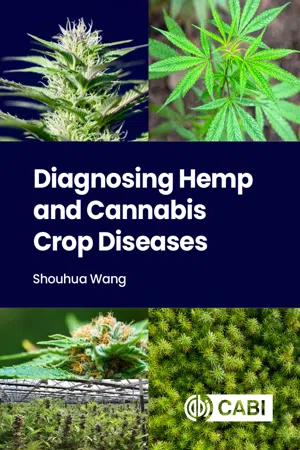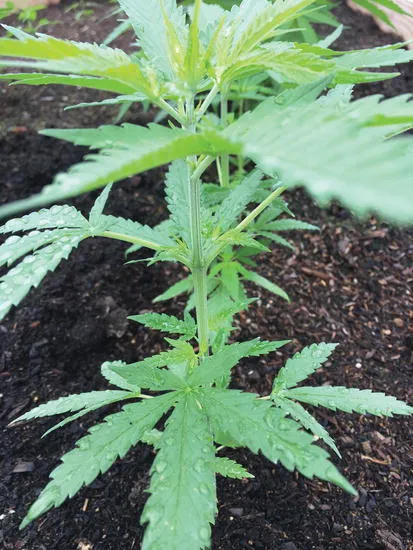
Diagnosing Hemp and Cannabis Crop Diseases
Shouhua Wang
- 256 páginas
- English
- ePUB (apto para móviles)
- Disponible en iOS y Android
Diagnosing Hemp and Cannabis Crop Diseases
Shouhua Wang
Información del libro
Hemp and cannabis, both belonging to Cannabis sativa, have emerged as some of the most valuable crops because of their multiple functionalities - industrial, medicinal, and recreational uses. Like all other crops, they are at risk of diseases and pests. In certain cases, an entire hemp field can fail due to unexpected disease. As a new and highly regulated crop, research on Cannabis crop diseases is scarce, and the science of plant diagnostics is not well covered in the literature. Taking hemp/cannabis as a model crop, the book illustrates how to diagnose a disease problem and how to manage it effectively. It presents real disease cases encountered during crop production, and explains methods of diagnosis, both in the field and in the lab, in order to find out the cause(s). The book provides: ·A field and laboratory guide to diagnosing hemp and cannabis diseases and pest problems·Ready-to-adopt skills, methods and protocols in plant diagnosis, which can be applied to other crops·Over 300 colour photographs accompanied by a wealth of disease information, including field observations, unique symptoms, microscopic details, and molecular data. This book is essential for anyone who is interested in learning about Cannabis crop diseases, for crops grown in the field, and in indoor production facilities.
Preguntas frecuentes
Información
Kingdom Plantae – Plants |
Subkingdom Tracheobionta – Vascular plants |
Superdivision Spermatophyta – Seed plants |
Division Magnoliophyta – Flowering plants |
Class Magnoliopsida – Dicotyledons |
Subclass Hamamelididae |
Order Urticales |
Family Cannabaceae – Hemp family |
Genus Cannabis L. – hemp |
Species Cannabis sativa L. – hemp or marijuana (cannabis) |
Hemp | Marijuana | |
Scientific name | Cannabis sativa | Cannabis sativa |
Statutory definition | The term ‘hemp’ means ‘the plant Cannabis sativa L. and any part of that plant, including the seeds thereof and all derivatives, extracts, cannabinoids, isomers, acids, salts, and salts of isomers, whether growing or not, with a delta-9 tetrahydrocannabinol [delta-9 THC] concentration of not more than 0.3 percent on a dry weight basis’. – Agricultural Marketing Act of 1946, Subtitle G, SEC. 297A | The term ‘marijuana’ means ‘all parts of the plant Cannabis sativa L., whether growing or not; the seeds thereof; the resin extracted from any part of such plant;and every compound, manufacture, salt, derivative, mixture, or preparation of such plant, its seeds or resin’. Such term does not include the mature stalks of such plant, fiber produced from such stalks, oil or cake made from the seeds of such plant, any other compound, manufacture, salt, derivative, mixture, or preparation of such mature stalks (except the resin extracted therefrom), fiber, oil, or cake, or the sterilized seed of such plant which is incapable of germination. – 21 U.S.C. § 802 (16), Title 21 – Food and Drugs |
US Laws governing Cannabis sativa | Agricultural Marketing Act of 1946 (AMA, 7 U.S.C. 1621 et seq.) Federal Food, Drug, and Cosmetic Act (FFDCA; 21 U.S.C. §§ 301 et seq.) | Controlled Substances Act (CSA, 21 U.S.C. §§ 801 et seq.) Federal Food, Drug, and Cosmetic Act (FFDCA; 21 U.S.C. §§ 301 et seq.) |
Primary Federal Regulatory Agencies | US Department of Agriculture (USDA), Food and Drug Administration (FDA) | US Drug Enforcement Administration (DEA), Food and Drug Administration (FDA) |
THC threshold defined | No more than 0.3% delta-9 THC on a dry-weight basis | Not specified |
Phytocannabinoids | More than 90 different cannabinoids have been reported in the literature (Andre et al., 2016) | More than 90 different cannabinoids have been reported in the literature (Andre et al., 2016) |
Physiological effect | Not psychoactive | Psychoactive |
Plant part harvested | Fibre, seed and flower | Flower |
Major use of products | Regular or functional foods, cosmetics, fabrics and industrial products | Recreational and medicinal products |
Common growing conditions | Farmlands and greenhouses | Secured indoor facilities |
Size of mature plants | 3.0–4.6 m for fibre crops, 1.8–2.7 m for seed crops and 1.2–2.4 m for flower or oil crops | 1.2–2.4 m |
